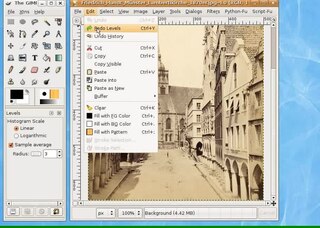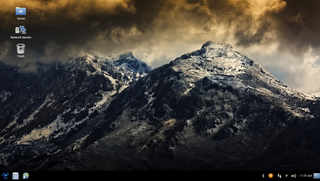Lightworks is a freemium non-linear editing system (NLE) for editing and mastering digital video. It was an early developer of computer-based non-linear editing systems, and has been in development since 1989. Lightworks won a 2017 EMMY Award for being one of the first to create digital nonlinear editing software. The development of an open-source version was announced on April 11, 2010. However, no source code of the program has been released. In July 2020, a Lightworks product manager confirmed that they "Still hope to announce something in the future" about Lightworks' open source development.

Adobe Premiere Pro is a timeline-based and non-linear video editing software application (NLE) developed by Adobe Inc. and published as part of the Adobe Creative Cloud licensing program. First launched in 2003, Adobe Premiere Pro is a successor of Adobe Premiere. It is geared towards professional video editing, while its sibling, Adobe Premiere Elements, targets the consumer market.

Windows Movie Maker is a discontinued video editing software program by Microsoft. It was first included in Windows Me on September 14, 2000, and in Windows XP on October 25, 2001. It was a part of the Windows Essentials software suite, and offered the ability to create and edit videos as well as to publish them on OneDrive, Facebook, Vimeo, YouTube, Windows Live Groups, and Flickr. It is comparable to Apple's iMovie.

Vegas Pro is a video editing software package for non-linear editing (NLE). The first release of Vegas Beta was on June 11, 1999. The software runs on Windows operating systems.

A screencast is a digital recording of computer screen output, also known as a video screen capture or a screen recording, often containing audio narration. The term screencast compares with the related term screenshot; whereas screenshot generates a single picture of a computer screen, a screencast is essentially a movie of the changes over time that a user sees on a computer screen, that can be enhanced with audio narration and captions.

Xfire was a proprietary freeware instant messaging service for gamers that also served as a game server browser with various other features. It was available for Microsoft Windows.
Timbuktu is a discontinued remote control software product originally developed by WOS Data Systems. Remote control software allows a user to control another computer across the local network or the Internet, viewing its screen and using its keyboard and mouse as though sitting in front of it. Timbuktu is compatible with computers running both Mac OS X and Windows.

Fraps is a benchmarking, screen capture and screen recording utility for Windows developed by Beepa. It can capture from software that uses DirectX and OpenGL, such as PC games.

BumpTop was a 3D desktop environment that simulates the normal behavior and physical properties of a real-world desk and enhances it with automatic tools to organize its contents. It is aimed at stylus interaction, making it more suitable for tablet computers and handheld PCs. It was created at the University of Toronto as Anand Agarawala's master's thesis. Agarawala also gave a presentation at the TED conference about his idea. The 1.0 version was released on April 8, 2009, along with a fully featured pro version as a paid upgrade. On April 30, 2010 the author announced that BumpTop was being discontinued and that they were taking the software "in an exciting new direction." Two days later, it was announced that the company had been acquired by Google. On January 5, 2011, Google released a sneak preview video of Android 3.0 Honeycomb showing a 3D desktop with features purportedly taken from BumpTop.

Trisquel is a computer operating system, a Linux distribution, derived from another distribution, Ubuntu. The project aims for a fully free software system without proprietary software or firmware and uses a version of Ubuntu's modified kernel, with the non-free code removed. Trisquel relies on user donations. Its logo is a triskelion, a Celtic symbol. Trisquel is listed by the Free Software Foundation as a distribution that contains only free software.
This page provides a comparison of notable screencasting software, used to record activities on the computer screen. This software is commonly used for desktop recording, gameplay recording and video editing. Screencasting software is typically limited to streaming and recording desktop activity alone, in contrast with a software vision mixer, which has the capacity to mix and switch the output between various input streams.
Snagit is screen capture and screen recording software for Windows and macOS. It is created and developed by TechSmith and was first launched in 1990. Snagit is available in English, French, German, Japanese, Portuguese and Spanish versions.
Camtasia is a software suite, created and published by TechSmith, for creating and recording video tutorials and presentations via screencast, or via a direct recording plug-in to Microsoft PowerPoint. Other multimedia recordings may be recorded at the same time or added separately. Camtasia is available in English, French, German, Japanese, Portuguese, Spanish and Chinese versions.

A screenshot is a digital image that shows the contents of a computer display. A screenshot is created by the operating system or software running on the device powering the display.

ScreenFlow from Telestream, Inc. is a screencasting and video editing software for the macOS operating system. It can capture the audio and video from the computer, edit the captured video, add highlights or annotation, and output a number of different file types such as AIFF, GIF, M4V, MOV, and MP4.

Windows 8 is a major release of the Windows NT operating system developed by Microsoft. It was released to manufacturing on August 1, 2012, and was made available for download via MSDN and TechNet on August 15, 2012. Nearly three months after its initial release, Windows 8 finally made its first retail appearance on October 26, 2012.

ActivePresenter is 3-in-1 eLearning authoring, screencasting, and video editing software for Microsoft Windows and macOS, which is developed by Atomi Systems, Inc. With this app, users can:

SimpleScreenRecorder is a Qt-based screencast software made for Unix operating systems, which handles similar tasks FFmpeg/avconv and VLC does.

ShareX is a free and open-source screenshot and screencast software for Windows. It is published under the GNU General Public License. The project's source code is hosted on GitHub. It is also available on the Microsoft Store and Steam.
Debut is a video capture and screencast program from NCH Software, available for both Windows and Mac.











